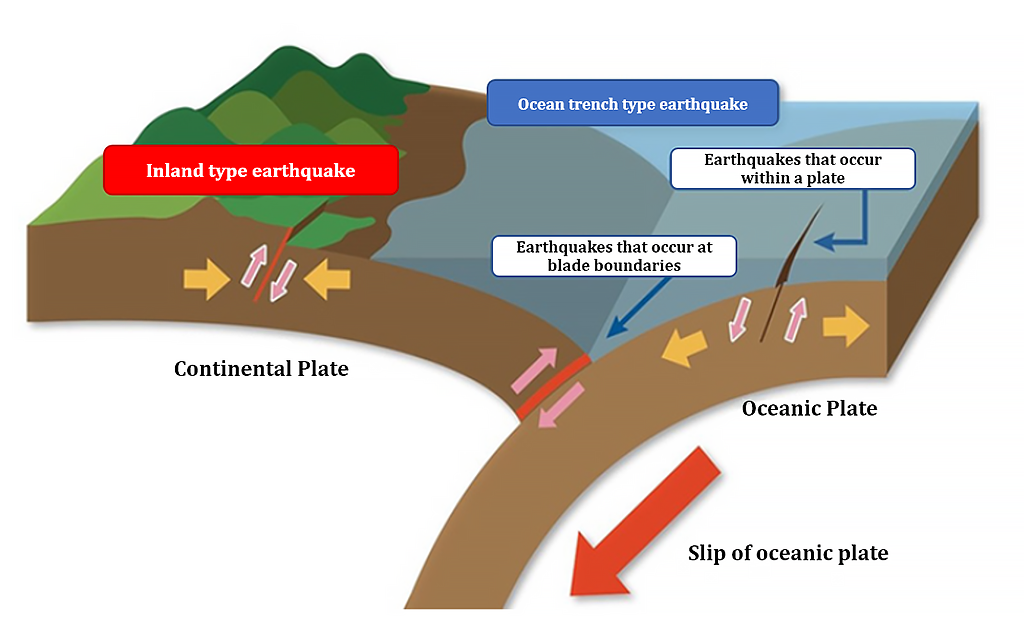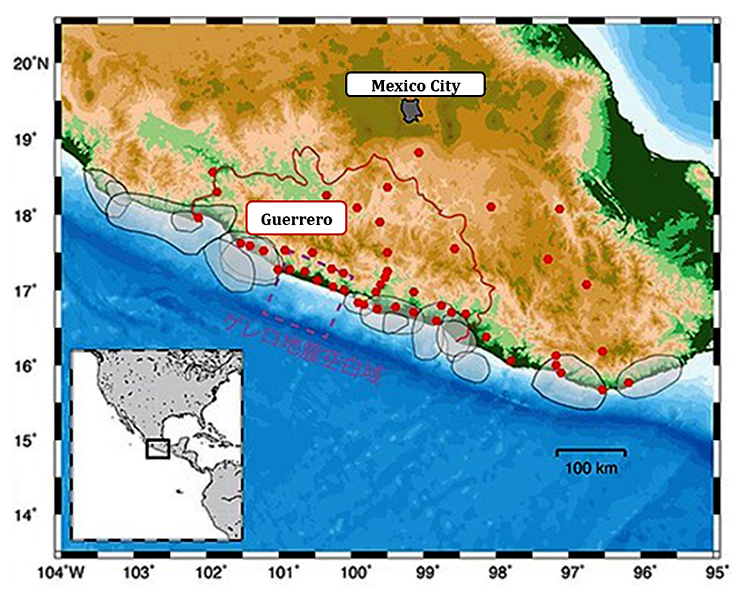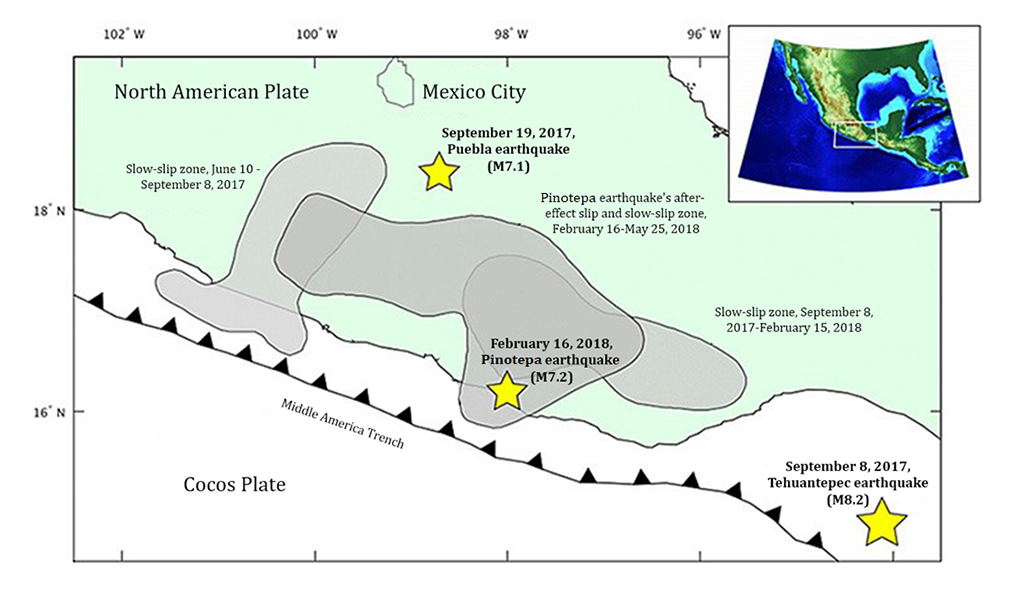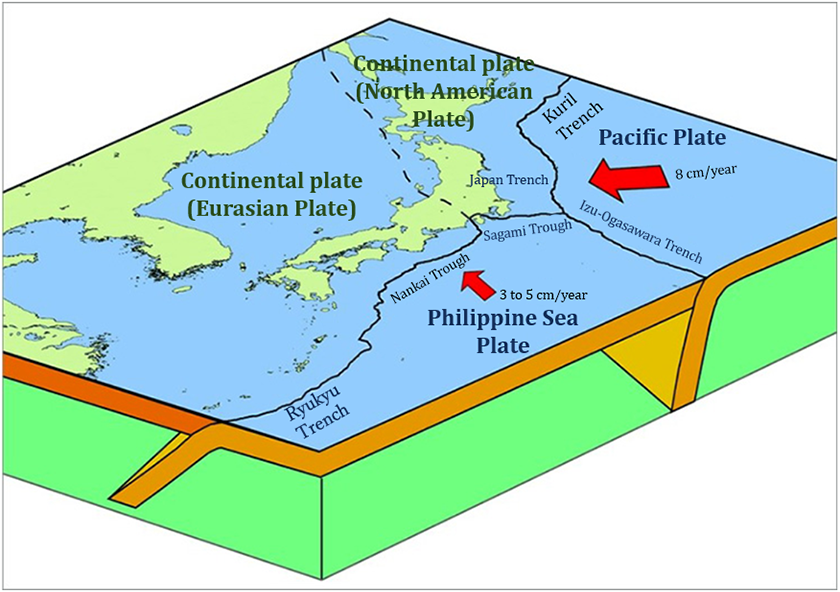In recent years, the study of earthquakes has progressed hand in hand with observation and theory by grasping crustal movements using satellites, GPS (Global Positioning System) and computer simulations, in addition to strengthening observation networks. One of the significant achievements is discovering "slow slip," a phenomenon in which the boundaries of underground plates slide without causing earthquakes.
In this context, an international research group led by Kyoto University announced that it has revealed, based on their observations, that large earthquakes and slow slips at plate boundaries or inside oceanic plates are interacting with each other. This outcome is essential for a better understanding of significant earthquakes involving plates, such as the Nankai Trough (shallow trench) earthquakes that have repeatedly been occurring from Suruga Bay to off the coast of Hyuga-Nada.
Targeting the "blank zone," three significant earthquakes captured
More than a dozen rigid plates cover the surface of the earth. Oceanic plates move a few centimeters per year and sink under continental plates. At the boundary between the two plates, strain accumulates, and when it reaches its limit, the oceanic plate slips all at once, causing a "plate boundary earthquake. In addition to the Nankai Trough earthquake, the Tokachi-oki earthquake in 2003 (M8.0) and the Great East Japan Earthquake in 2011 (M9.0) are also examples of such earthquakes.

(Provided by the Headquarters for Earthquake Research Promotion)
There have been micro tremors, like slow slips, reported since around 2000, which are thought to be affecting the occurrence of large earthquakes. Some case examples indicate that significant quakes were triggered by slow slips in the surrounding area and vice versa. However, although possible impacts were seen by connecting the phenomena in a time series, the mechanism has not been explained concretely based on the observations.
Then, the research group enhanced their GPS and seismic observation systems around the state of Guerrero in Mexico, which faces the Pacific Ocean, and observed three significant earthquakes that occurred in 2017-18 and slow slips in the area.

(Provided by Kyoto University)
In this area, "the Cocos Plate," an oceanic plate has slipped beneath the "North American Plate," a continental plate, which has repeatedly caused significant earthquakes. Despite that, there is a "blank zone," where no major earthquake has occurred for many years, and the research group thought the risk of earthquake occurrence was increasing there. Therefore, they targeted it in advance and succeeded in their observation. Deep in the plate boundary in this area, slow slips were occurring at intervals of four to five years.
The three significant earthquakes are as follows.
- (1) September 8, 2017, Tehuantepec earthquake (quake inside an oceanic plate, M8.2)
- (2) September 19, 2017, Puebla earthquake (quake inside an oceanic plate, M7.1)
- (3) February 16, 2018, Pinotepa earthquake (plate boundary quake, M7.2)
The group analyzed the crustal movement data of 57 GPS observation sites in detail. They captured slow slips and determined the time variations of the degree of strain accumulation between the plates.
Interactions: "It meant a lot that we were able to demonstrate the existence of interactions properly"
As a result, It was figured out that the three earthquakes could be explained as chain reactions interacting with slow slips. Specifically, (1) the Tehuantepec earthquake made the plate boundary slippery and disrupted the slow slip cycle, which changed the way forces were applied inside the oceanic plate, triggering (2) the Puebla earthquake. Because of this, slow slips continued to occur, accumulating strain, which led to the occurrence of (3) the Pinotepa earthquake. After that, slow slip became active again.

(Provided by Kyoto University)
Yoshihiro Ito, a member of the research group and an associate professor of seismology at the Disaster Prevention Research Institute (DPRI) of Kyoto University, says, "Earthquakes triggered the next earthquake through slow slips. I'm sure we have explained the respective interactions based on actual observations for the first time. It meant a lot that we were able to catch slow slips to demonstrate the interactions properly."
The research group consists of Ito, Associate Professor Takuya Nishimura at DPRI of Kyoto University, the National Autonomous University of Mexico, the University of Rhode Island, and the University of California Santa Cruz. The research was conducted as part of the Science and Technology Research Partnership for Sustainable Development (SATREPS) program by organizations like the Japan Science and Technology Agency (JST) and the Japan International Cooperation Agency (JICA). Kyoto University announced the results on April 15, following the post on the British science journal Nature Communications on April 12 (Japan time).
Ito also says, "The occurrence of a slow slip does not necessarily result in a massive earthquake but, although the probability is low, we can say the chance may increase tenfold in the next ten days" (compared to when there is no slow slip).
Nankai Trough Earthquake may occur earlier due to slow slips
Although this study takes place in Mexico, there seems to be much to be gained in understanding the area around the Japanese archipelago, where four plates come together to form one of the world's largest seismic zones. After the Great East Japan Earthquake, the relationship between the mainshock and slow slip and other phenomena attracted attention. It turned out that slow slips had been occurring in the epicenter area for a month.
Nankai Trough earthquakes have been occurring in 100 to 200-year cycles, and it has been more than 70 years since the previous Showa Tonankai Earthquake (1944) and the Showa Nankai Earthquake (1946). The last year's edition of the National Seismic Hazard Map compiled by the government's Earthquake Research Committee last month assesses the probability of an M8-9 earthquake occurring along the Nankai Trough within 30 years at 70-80%. Measures for detecting earthquakes and tsunamis, such as a submarine observation network, are getting underway.

(Provided by the Japan Meteorological Agency)
"If we consider Nankai Trough earthquakes based solely on the occurrence cycle, we can say we still have time. However, if a major earthquake strikes around Japan, phenomena like slow slips will become active along the Nankai Trough, and an earthquake may occur sooner than expected. Earthquakes in distant countries could also trigger it," Ito warns.
In other words, we can't simply say, "It has been happening in a cycle of certain years so the next one will be in a certain year." We need to understand more about the interactions between earthquakes and slow slips. "In doing so, it is important to strengthen our observations, including those of the seafloor, to keep track of slow slips, and to increase the number of research cases," says Ito.
Through the outcomes of this project, we reacknowledged the complexity of earthquake occurrence. Earthquakes threaten our lives and safety, but we cannot take measures to prevent their occurrence, unlike diseases or accidents. It is frustrating that we cannot precisely predict earthquakes because they occur in the invisible underground world. Nevertheless, accumulating observations and knowledge will likely give us hope to grasp the increased risk of occurrence and reduce the damage. We should continue to pay attention to such diligent research while keeping past earthquake disasters in mind and being prepared.
Original article was provided by the Science Portal and has been translated by Science Japan.




